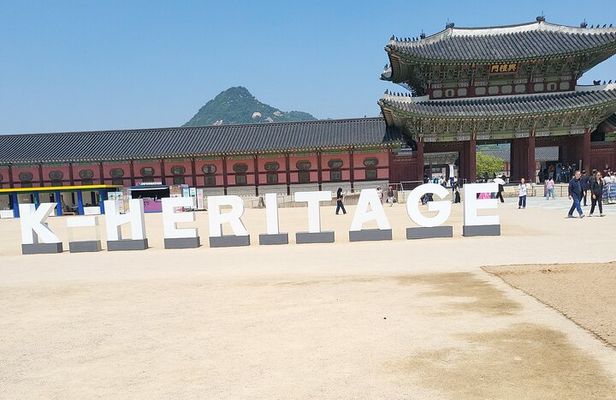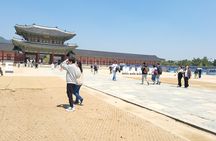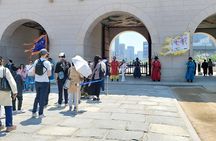
No expiration date
Easy refund
Free exchange
Easy booking
Half or Day Private Tour For Cruise Incheon and Seoul City Tour
$95
This is an experience gift voucher. The recipient will book the experience after
they redeem the gift voucher.
Overview
The name Gyeongbokgung contains the meaning that "the new dynasty will enjoy great fortune and prosper."
The Gyeongbokgung Palace tour provides an opportunity to increase your understanding of Korean culture. In addition, Gyeongbokgung Palace offers traditional performances such as the Changing of the Royal Guard Ceremony held every day at noon, providing foreigners with a chance to experience Korean traditions vividly.
Insa-dong has galleries, traditional tea houses, restaurants, street vendors, specialized shopping malls for handicrafts, antique shops, antique stores, and flower shops, so I recommend taking a walk and eating bibimbap.
Take a walk along Bukcheon Hanok Village Road and feel and experience the beauty of Korean culture.
Gwangjang Market is the first permanent market in our country, established in 1905. The Korean pronunciation of the name was kept the same, but the meaning of ‘widely gathering and preserving’ was added, and it became the current Gwangjang Market.
The Gyeongbokgung Palace tour provides an opportunity to increase your understanding of Korean culture. In addition, Gyeongbokgung Palace offers traditional performances such as the Changing of the Royal Guard Ceremony held every day at noon, providing foreigners with a chance to experience Korean traditions vividly.
Insa-dong has galleries, traditional tea houses, restaurants, street vendors, specialized shopping malls for handicrafts, antique shops, antique stores, and flower shops, so I recommend taking a walk and eating bibimbap.
Take a walk along Bukcheon Hanok Village Road and feel and experience the beauty of Korean culture.
Gwangjang Market is the first permanent market in our country, established in 1905. The Korean pronunciation of the name was kept the same, but the meaning of ‘widely gathering and preserving’ was added, and it became the current Gwangjang Market.
—
The experience offers several options. This price includes:
8up to12 person Half day tour
Duration: 6 hours
Half day tour: Gyeongbokgung Palace
Insa-dong street
National Folk Museum of Korea
Solrati bus : 12 person seater Bus
Half day private tour : With solrati taxi Driver
Pickup included
Duration: 6 hours
Half day tour: Gyeongbokgung Palace
Insa-dong street
National Folk Museum of Korea
Solrati bus : 12 person seater Bus
Half day private tour : With solrati taxi Driver
Pickup included
Tour guide
Language: English
Human tour guide
The experience offers several options, check yours above
- We always provide taxis registered in south of Korea.(All taxis include transportation insurance.)
- If we have time, we can change the Day tour course as per your request.
- We will recommend tours to the Seoul tour locations that customers want first.
- Tour is conducted best driver who has a lot of experience in foreign tours & speaks a little English
- Air-conditioned vehicle/ All admission fees are included
- No additional charge for drop-off in Incheon Airport, Seoul Airport, Incheon City, Seoul City).
- Even for tours of 1 to 4 people, we provide a 7-seater jumbo taxi. (If not available, Regular taxi.)
- Gratuities not included (Recommend )/ Food and drink / personal Expenses
-
It takes about( 30minutes or 1 hour and 30 minutes to pick up customers at Incheon Port or Seoul city area and drive to Seoul Gyeongbokgung Palace. This is a driving course to Seoul where you can enjoy sightseeing in the city and listen to information about the Republic of Korea on the taxi driver's smartphone audio. The drive from Incheon Cruise to downtown Seoul may take longer due to traffic congestion. We appreciate your understanding.
-
Gyeongbokgung PalaceAccording to a story, the name Seoul was first used during the Joseon Dynasty when Jeong Do-jeon accompanied King Taejo Yi Seong-gye to Bukaksan Mountain. It was March, so the surrounding mountains were covered in snow. The land inside looked like it was inside a snow fence, so he called it Seol-ul, which became Seoul. The name Gyeongbokgung Palace contains the meaning that "the new dynasty will enjoy great fortune and prosperity." You will experience the essence of the noble and dignified royal culture. It is located against Bukhansan Mountain to the north, and you can admire the main gate, Gwanghwamun. You can also experience wearing Hanbok, and feel traditional Korean culture. The Gyeongbokgung Palace tour provides an opportunity to gain a deeper understanding of Korean culture. Traditional performances, such as the Changing of the Royal Guards Ceremony held every day at noon, provide foreigners with a vivid experience of Korean tradition.
-
National Folk Museum of KoreaThe National Folk Museum of Korea is an organization under the Ministry of Culture, Sports and Tourism of the Republic of Korea that oversees the collection, preservation, investigation, research, exhibition, education and exchange of lifestyles, customs and practices of the Korean people and countries around the world, as well as the tools and materials used for them. The National Folk Museum of Korea is a national museum under the Ministry of Culture, Sports and Tourism established to collect, preserve and exhibit unique folk materials and systematically investigate and research related to them. It is closed on January 1, Lunar New Year's Day and Chuseok. The main building has a children's museum under its wing.
-
Bukchon Hanok VillageBukchon is a representative traditional residential area in Seoul, located between Gyeongbokgung Palace, Changdeokgung Palace, and Jongmyo Shrine, where traditional hanok houses are densely packed. It is also called a street museum in the city center because it has many historical sites, cultural assets, and folk materials. It is called ‘Bukchon (North Village)’ because it is the upper neighborhood of Cheonggyecheon and Jongno, and it includes Gahoe-dong, Songhyeon-dong, Anguk-dong, and Samcheong-dong. Sagan-dong, Gye-dong, Sogyeok-dong, and Jae-dong are places where historical traces remain and have been preserved for hundreds of years. In order for Bukchon Hanok Village to become a sustainable tourist destination, it is important to practice silent tourism.
-
InsadongInsa-dong is a car-free street representing Seoul, and is a must-see attraction in Seoul. There are galleries, traditional tea houses, restaurants, street vendors, handicraft shops, Janmun shopping malls, antique shops, craft shops, and flower shops, so take a walk and spend some time there, and try Korean bibimbap. You will see, feel, and experience the appearance of a street with Korean characteristics, and you will have a unique memory of seeing, feeling, and experiencing a cultural aspect.
- Changgyeonggung Palace is the third palace built during the Joseon Dynasty, following Gyeongbokgung Palace and Changdeokgung Palace. Since the early days of the Joseon Dynasty, the two-palace system was in place, with Gyeongbokgung Palace as the main palace and Changdeokgung Palace as the auxiliary palace. However, the kings of the past preferred to reside in Changdeokgung Palace over Gyeongbokgung Palace, and as the royal family grew, the living space in Changdeokgung Palace gradually became cramped. Accordingly, King Seongjong built Changgyeonggung Palace next to Changdeokgung Palace so that the three queens of the royal family, including Queen Jeonghui, wife of King Sejo, Queen Ansun, wife of King Yejong, and Queen Sohye, wife of King Deokjong, could live comfortably. The name at the time was Suganggung Palace, meaning longevity and peace. (pass by)
- This is also because it is a place where people from countries that participated in the Korean War, such as the United States, the United Kingdom, and Canada, can feel deeply moved because it has a facility that commemorates and pays tribute to each and every one of the veterans along with large flags of the countries that participated in the Korean War as part of the United Nations forces in 1950, and monuments for each of them. It is a must-visit place for foreign veterans or their descendants visiting Korea. When descendants of veterans come to Korea, they are often moved to see the names of their ancestors, who are not remembered in their home country, proudly engraved on the walls of the War Memorial of Korea, and they often diligently make rubbings of them. (pass by)
-
Kwangjang MarketIt is the first permanent market in Korea, established in 1905. Originally, Gwangjang Market was planned to be built by covering the area between Gwanggyo (wide bridge) and Janggyo (long bridge), so it was named Gwangjang Market, meaning “wide and long,” after the first letters of the bridge names. However, when it was moved to Baeogae, the Korean pronunciation of the previous name was kept, but the meaning of “widely gathering and preserving” was newly added, and it became the current Gwangjang (廣藏) Market. Now, more than 100 years later, it has become a comprehensive market boasting a considerable transaction volume. Also, the busiest place in Gwangjang Market is the food market formed on the street where Dongmun, Buk 2 Gate, and Nam 1 Gate meet. The food market of Gwangjang Market attracts all ages, from students, middle-aged people, and the elderly. It is currently designated as a world tourist course, and is famous as a transit point for many foreign tourists traveling to Korea.
- This is also because it is a place where people from countries that participated in the Korean War, such as the United States, the United Kingdom, and Canada, can feel deeply moved because it has a facility that commemorates and pays tribute to each and every one of the veterans along with large flags of the countries that participated in the Korean War as part of the United Nations forces in 1950, and monuments for each of them. It is a must-visit place for foreign veterans or their descendants visiting Korea. When descendants of veterans come to Korea, they are often moved to see the names of their ancestors, who are not remembered in their home country, proudly engraved on the walls of the War Memorial of Korea, and they often diligently make rubbings of them. (pass by)
-
Sungnyemun GateSungnyemun (崇禮門) can be seen as a name that reflects the ideological orientation of the Joseon Dynasty. The name of the South Gate, Sungnye, means 'to raise etiquette' and is taken from the Doctrine of the Mean, one of the four books of Confucianism. The 'Sungnyemun Guarding Ceremony' that protects Sungnyemun It is a beautiful cultural heritage of the historic city of Seoul. Pasu (把守) refers to defending the capital city and was one of the important military ceremonies of the Joseon Dynasty. The 'Sungnyemun Guarding Ceremony' is held every day of the year except for Mondays. The Sungnyemun Opening Ceremony time is 10:00 to 10:10. The guarding ceremony time is 10:10 to 10:45, and you can take pictures with the guards.
-
Cheonggyecheon StreamCheonggyecheon is located between Sungnyemun and Gyeongbokgung Palace, making it a great place for a walk. Because of Cheonggyecheon, Seoul is a human-centered environmental city, and it is a must-see tourist course for foreign tourists, connecting the world-class Cheonggye Plaza with various sculptures (Statue of Yi Sun-sin, Statue of King Sejong) and Seun Shopping Center and surrounding tourist attractions where the energy of the world gathers. Since the opening of Cheonggyecheon, the cumulative number of visitors, including foreigners, has reached approximately 190 million over the past 10 years from 2005 to 2015, and you can take a walk around downtown Seoul on the way to Gyeongbokgung Palace.
- Jongmyo is the tomb of kings with long reigns. It was originally built to house the tombs of the five kings including Taejo, his father and grandfather. A total of 19 chambers house the spirit tablets of the kings and queens of the Joseon Dynasty. Kings with short reigns are enshrined in separate locations. It is also called Jongmyo Daeje because it is the largest and most important ritual among the rituals, and it is held at Jongmyo, a World Heritage site, to house the spirit tablets of the kings and queens of the Joseon Dynasty. Jongmyo Daeje is held every year on the first Sunday in May and the first Saturday in November. Jongmyo Daeje is a comprehensive ritual that is rare in the world, where you can enjoy not only the ritual but also tangible and intangible world heritages such as ritual music and dance. (pass by)
-
Bugak SkywayBukak Sky Palgakjeong Pavilion, a hanok-style pavilion perched 342 meters above sea level on Bukaksan Mountain, is a prime tourist attraction in the heart of Seoul, boasting a prime location. Opened in September 1968, the Bukak Skyway is a renowned driving route leading to Bukak Palgakjeong, Seoul's main peak. From Bukak Palgakjeong Pavilion, the magnificent scenery of Bukhansan Mountain's Bibong and Munsubong peaks unfolds on one side, while Namsan Mountain offers a breathtaking view of Seoul on the other. The pavilion boasts well-maintained street trees and approximately 100,000 ornamental trees, each blooming with seasonal flowers. Along with the Namsan Ring Road, the pavilion offers a breathtaking panoramic view of Seoul. It serves as a tourist attraction for both domestic and international visitors, offering a glimpse of Seoul at a glance.
-
South KoreaAfter finishing the tour of Seoul City, it is time to return to the Incheon Port Cruise. The trip takes about 1 hour and 30 minutes.
How it works?
01
—
You choose from 10,000+ experience gifts
02
—
We deliver the eVoucher or the Physical box to the recipient
03
—
Recipient books the experience and creates unforgettable memories!
Half or Day Private Tour For Cruise Incheon and Seoul City Tour
$95
This is an experience gift voucher. The recipient will book the experience after
they redeem the gift voucher.
How it works?
01
—
You choose from 10,000+ experience gifts
02
—
We deliver the eVoucher or the Physical box to the recipient
03
—
Recipient books the experience and creates unforgettable memories!




